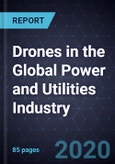Technological Advancements in AI, Nanotechnology and IOT will Drive the Adoption of Drones in the Power and Utilities Industry
Drones or unmanned aerial vehicles (UAVs) are currently finding application opportunities across various commercial businesses and are poised to impact multiple industry verticals in various capacities. Drone applications are emerging in various sectors such as agriculture, mining, oil and gas (O&G), construction, utilities, and environmental conservation. Technological advancements are making it easier to execute complex and diverse data gathering exercises. Innovation in packaged software products and data visualization makes the process more accessible, efficient and convenient to end-users. The evolution of drones over the last 5 years and the convergence of AI, technological innovations, analytics, and IoT will drive the widespread adoption of drone technology over the course of the next decade.
The global power & utilities industry is undergoing a massive shift driven by three main trends - decarbonization, decentralization, and digitalization. Utilities, independent power producers (IPPs) and other power companies have started leveraging digital technologies such as artificial intelligence (AI), robotics, machine learning (ML), cloud computing, edge computing and other technical innovations like drones to fundamentally address their business problems, and as well disrupt processes, value chains, and business models.
The successful application of drones across other business verticals has concentrated attention across the power sector and, while at a nascent stage, has seen a surge in activity in recent years, particularly in the transmission & distribution (T&D) segment. Utilities have started acknowledging the role played by drones in providing reliable, safe and efficient inspections of power generation and T&D assets. As the power & utilities industry continues to transform, drone technologies will continue to find more applications to improve process efficiency, prevent damage before it could occur (predictive and prescriptive maintenance) and extend lifetimes of assets.
Research Scope
The study period is from 2019 to 2030, with 2019 as the base year. The forecast period is from 2020 to 2030. The publisher's revenue estimation represents only the revenue generated by drone service providers (DSPs) offering drones services to their customers and does not include revenue generated through the sales of drones.
Market information for the base year has been obtained from both primary and secondary research data and analyses. Key trends and information on market size, tiers of competition and other variables are based on discussions with key industry stakeholders in the value chain.
Key Issues Addressed
- What is the status quo in the global drone services market and how will this evolve in the future?
- What are the key factors - both regulatory and non-regulatory - that are likely to drive or restrain future market growth?
- What are the different business models that are likely to be adopted?
- What are the principal use cases for drones in the power sector?
- Which companies are the key competitors in the market?
Table of Contents
Companies Mentioned (Partial List)
A selection of companies mentioned in this report includes, but is not limited to:
- Aerodyne
- Cyberhawk
- DroneView Technologies
- Measure
- PrecisionHawk
- Terra Drone








